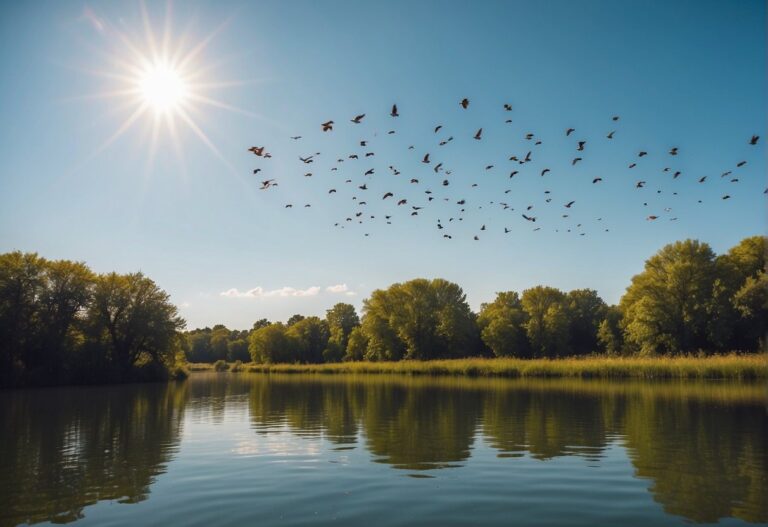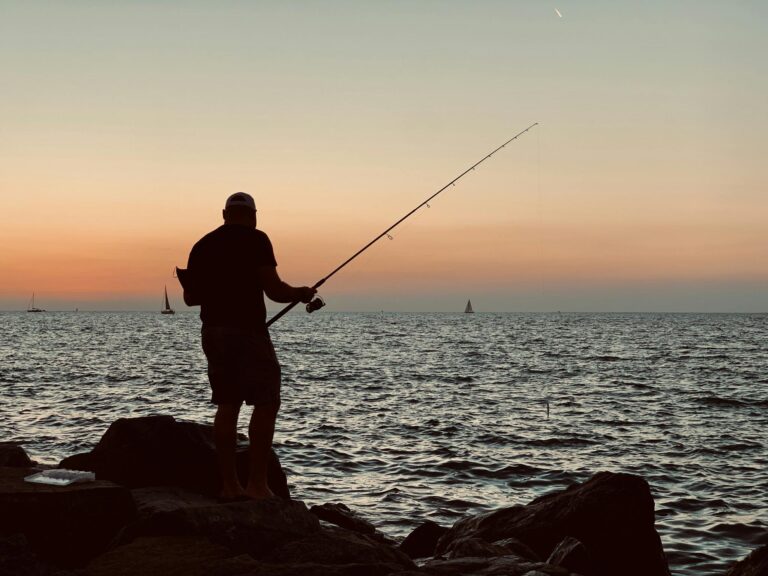How to Use a Fishing Rod: Essential Tips for Beginners
Using a fishing rod can feel like holding a magic wand in your hands. With a flick of the wrist, you can cast a spell on fish swimming in their watery realm. But unlike conjuring spells, learning to use a fishing rod doesn’t rely on mystical powers.
It’s a skill that you can master with a little practice and patience. Whether you’re an aspiring angler or someone who wants to reel in a catch after a leisurely day at the lake, knowing how to properly use a fishing rod is the first step in your fishing adventures.

Think of your fishing rod as an extension of your arm. It’s a tool that, when used correctly, brings the thrill of catching a fish from a mere dream into your hands.
You’ll become familiar with terms like ‘reel’, ‘cast’, and ‘tackle’, and these words will be the building blocks you use to communicate with the finned creatures of the deep.
As you become more adept, you’ll start to understand that fishing is much more than tossing a line into the water. It’s an art form where you dance with nature, and your rod is your dance partner.
With a careful blend of finesse and force, you’ll learn how to send your lure sailing to the spot where fish are frolicking. At the same time, you’ll keep a close watch on the tautness of your line to ensure that you don’t miss a subtle nibble.
The right technique will have you reeling in your fish instead of telling stories about the one that got away. So, grab your rod and gear up for an adventure where every cast brings a chance of a new discovery just beneath the water’s surface.
Understanding Fishing Rod Basics
Before you can become an angler who reels in stories of “the one that didn’t get away,” it’s important to understand the ins and outs of your primary tool: the fishing rod.
Grasping the differences between rod types, materials, lengths, action, and power will equip you with the know-how to select the perfect rod for your aquatic adventure.
Types of Fishing Rods
- Spinning Rods: These are your trusty steeds – easy to use and versatile, perfect for beginners and pros alike. They let the reel hang beneath the rod and are excellent for lighter baits and lures.
- Casting Rods: Serving more accuracy, these rods require a cowboy’s touch, as they allow you more control over your lure. Your reel sits atop these rods, and they come in two varieties: baitcasting for the experienced angler and spin casting for those who like a good mix of simplicity and control.
Fishing Rod Materials
- Graphite Rods: The sprinters of rods – sensitive, light, and quick for your reflexive strikes. But watch out, graphite is your high-performance sports car; powerful yet more prone to breaking under stress.
- Fiberglass Rods: The SUVs of the rod world – they may not respond like graphite, but they’ll last through your fishing marathons and forgive the occasional mishap.
Rod Length and Its Importance
Determining the right rod length is like choosing the perfect dance partner; it’s all about finding the right fit for your style:
- Short Rods (Under 6 feet): Great for close combat with your aquatic adversaries when you’re wrestling in the brush or jigging for jigging.
- Long Rods (Over 8 feet): When you want to cast your line like a romantic poem across the water, reaching the far-off places where fish whisper their secrets.
Rod Action and Power
Understanding rod action and power is like learning a secret handshake in the world of angling.
Rod Action:
- Fast Action: These rods bend mostly near the tip, and they’re like the quick-twitch muscles in your body, ideal for fast hook setting.
- Moderate Action: Offering a balance, these rods bend in the top half and are the all-rounders – good for a variety of lures and conditions.
- Slow Action: Like a stretching yoga instructor, these bend throughout the rod and are forgiving with your fish, providing a smoother fight.
Rod Power:
- Ultralight to Light: Suited for the stealth approach, perfect for smaller species where the thrill is in the finesse of your technique.
- Medium to Heavy: When you’re after the behemoths of the deep, these rods provide the backbone you need to wrestle them to submission.
Setting Up Your Fishing Rod

Getting your fishing rod ready is like assembling a trusty sword before a battle. Each piece plays a critical role, and putting them together correctly ensures your time on the water is not only successful but enjoyable.
Assembling the Components
- Handle: This is the part you’ll hold onto for dear life when reeling in the big one. Make sure it’s firmly attached to the rod.
- Guides: These are the small rings along the rod through which the fishing line will be threaded. Ensure they are all aligned perfectly straight.
Attaching the Reel
- Identify the type of reel you have: spinning reel, baitcaster, or fly reel.
- Find the reel seat on your rod — this is where the reel will call home.
- If using a spinning reel or baitcaster:
- Place the reel foot into the reel seat.
- Clamp down the reel by tightening the reel seat until the reel is secure.
Threading the Fishing Line
- Start at the reel, threading the line through each guide.
- Use a method that keeps the line taut to avoid twists and tangles.
- Continue threading until you have reached the tip of the rod.
Tying the Knot
- Choose your knot—Clinch knot, Palomar knot, or Improved clinch knot are reliable choices.
- For a Clinch Knot:
- Pass the line through the eye of the hook.
- Wrap the end around the standing line five or six times.
- Insert the loose end back through the loop you’ve made near the eye of the hook.
- Moisten the line (a bit of saliva works wonders).
- Pull both ends to tighten and trim any excess.
Choosing Your Tackle

Before you cast a line, understanding the interplay between your target species and the tackle you choose is key to a successful catch. Let’s get into the nitty-gritty of selecting the right lure or bait and the hooks that make all the difference.
Selecting the Right Lure or Bait
Your choice here is essentially the appetizers on the menu for those underwater patrons. Different species have different tastes, so match your lure or bait to what the fish are feeding on in their natural habitat.
- Jigs: Versatile little dancers of the lure world, use these when you’re after a variety that nibbles at the bottom.
- Spinnerbaits: Flashy and in motion, they’re perfect for catching the eye of species like bass.
- Spoons: These wobbly pieces of metal mimic an injured fish, ideal for pike or trout.
- Crankbaits: Resembling small baitfish, these are your go-to for species that prey on tiny swimmers.
- Flies: For the artist in you, flies require a delicate touch and appeal to the sophisticates like trout.
Don’t forget live bait, such as worms or minnows, which can be more effective than a stand-up comedian at an open-mic night for attracting a wide range of fish.
Understanding Hooks and Their Sizes
The hook is your handshake at the interview for the big catch. It’s a seemingly simple tool, but its role is crucial. Here’s the straight hook, with no bends or barbs in the tale:
- Size Matters: Hook sizes range from the diminutive 32 to the mammoth 19/0. In general, match the hook size to your target species’ mouth. Tiny for the small-mouthed crappie and the large for the gaping mouth of a catfish.
- Types of Hooks:
- A worm hook is used primarily for soft plastic baits and comes with a shank that’s great at hiding within the lure.
- Traditionalists looking for versatility might find a good friend in the Aberdeen hook, which is good for live bait and won’t make too big of a hole.
Mastering Casting Techniques

Before you can reel in the big one, you’ve got to master the art of sending your lure flying. Think of casting as a dance between you, the rod, and the water—get the steps right, and you’ll be hitting that water with precision every time.
The Basics of Casting
To start off on the right foot (or should we say the right cast?), it’s vital to get a grasp on the fundamentals.
Here’s how you set the stage for a perfect performance:
- Position Yourself:
- Plant your feet shoulder-width apart, just as if you’re bracing for a gentle breeze. Then, square your shoulders to your target like an archer eyeing the bullseye.
- Grip it Right:
- Grasp your fishing rod with confidence—like a handshake with an old friend. Keep that index finger ready to work its magic.
- The Rod Tip:
- Keep the tip of the rod pointed towards your target, as if you’re pointing out where the fish are hiding.
- Lever Pressure:
- Apply just enough pressure with your index finger to keep the line snug against the rod. It’s like holding a fragile egg without cracking it.
- Load and Launch:
- With a smooth backswing, feel the rod load up with potential energy—imagine a slingshot in your hands. Then, with the grace of a maestro, swing it forward and release the line to send your lure soaring towards the spot where you just know the fish are having a party.
Advanced Casting Methods
So, you’ve got the basics down pat, but you’re itching for a bit of a challenge? Let’s spice up your casting with a couple of advanced techniques:
Overhead Casting:
- Consider it your bread and butter, reaching long distances and helping you cover more watery real estate.
- Technique:
- With a fluid motion, raise the rod over your head and fling it forward as if you’re throwing a javelin in the style of an Olympian. Finish with the rod tip down towards the water.
Pitching:
- When you’re in a tight spot and need to thread the needle, pitching is your go-to move—like sneakily flicking a pea across the dinner table.
- Technique:
- Hold the lure in your hand, gently swing the rod tip, and let go of the lure as you point the rod tip directly at your target. Make sure to ensure a soft landing that fish won’t hear coming.
Fishing Rod Care and Maintenance
Proper care and maintenance of your fishing rod will ensure it remains your reliable partner cast after cast. Like a trusted friend, it deserves your attention and respect to maintain its quality and performance.
Cleaning Your Rod
Keeping your fishing rod clean is like keeping your car spotless—it’s not just about looks, it’s about performance. Here’s how:
- After each use, gently rinse the rod with fresh water to remove any dirt, salt, or grime.
- Dry it thoroughly with a soft cloth to avoid water spots and potential corrosion.
- Occasionally, give your rod a more in-depth clean:
- Remove all the hardware and wash with mild soap.
- Apply rubbing alcohol on a white towel and give the handle and reel mount a rigorous but caring scrub. Think of it as giving your rod a spa day.
- To keep the joints moving smoothly, a dab of candle wax will make them as graceful as a ballerina.
Storing Your Equipment Properly
Storing your gear is like tucking in your kids—doing it right avoids nightmares.
- Vertical racks are the superhero stance of storage, keeping your rods upright and ready for action.
- But if you must go horizontal, check these tips:
- Use a rack or supports to prevent your rods from bowing down to pressure over time.
- Ensure that no weight is placed on the tips, or they’ll get a permanent bend, like a lopsided grin.
Using the Right Rod for Different Fishing Scenarios
Selecting the right rod can make the difference between a good fishing day and a great one. It’s like choosing the perfect dance partner for a tango; pick right, and you’ll be in harmony with the waters you navigate.
Freshwater vs. Saltwater Fishing
Freshwater Fishing:
- Spinning Rods: Your go-to for flexibility and ease of use. They’re like a Swiss Army knife—versatile and dependable for most freshwater scenarios.
- Casting Rods: Think of these as your precision instruments. Bass fishing aficionados might treasure a casting rod when accuracy is the main act.
Saltwater Fishing:
- Heavier Spinning Rods: These beefier versions of freshwater spinning rods are crafted to handle the ocean’s bruisers. The added sturdiness is akin to wearing armor in battle.
- Surf Rods: Like using a trebuchet to launch your bait, these rods let you cast further to reach the distant sea creatures.
Targeting Specific Fish Species
Bass:
- Medium-Heavy Casting Rods: Ideal for pulling those feisty bass out of their aquatic hideouts with a tug-of-war gusto reminiscent of a medieval knight besting a dragon.
Fly Fishing for Trout:
- Fly Rods: With finesse and grace, wave your magic wand, cast the fly upon the water’s surface, and beckon the trout like a siren’s call.
Ice Fishing:
- Ice Fishing Rods: Short, stout, and sturdy—think of a sumo wrestler in rod form—these rods are built to work in the confined spaces of an ice hut and the cold world beneath the ice.
Additional Considerations and Tips
Before you cast your next line, remember that mastering a fishing rod isn’t just about the basics. It’s also about understanding the finer details that can make or break your angling adventure.
Understanding Rod Guides
Rod guides might seem like small fries in the big pond of fishing gear, but they’re actually crucial for casting and reeling in the big ones. They are the little rings that run along the length of your rod and do the heavy lifting of guiding your line from reel to tip. Here’s what you need to know:
- Material Matters: Look for guides made with durable materials like silicon carbide or aluminium oxide to withstand the friction of a line dancing its way through during a lively fight.
- The Bigger Picture:
- The size and taper of the guides influence your casting distance and accuracy. Smaller guides closer to the tip can help with precision casting, while larger ones near the handle boost your casting distance.
Adjusting to Environmental Elements
Just like a weatherman adjusts his forecast with changing skies, you need to adapt your fishing strategy to the environment’s whims.
- Wind and Waves:
- Breezy conditions call for adjustments in your casting technique and potentially a heavier power rod to punch through the gusts.
- Sunny or Shady?:
- Not just a question for picnic-goers. Sunlight or lack thereof affects water temperature and fish behavior. Match your tactics accordingly, and you may just snag that elusive catch.
- To Scale or Not to Scale:
- When the environment is your stage, consider the fish scale – literally. Smaller lures for clear days, and go big or glow home when overcast.
Streamlining Your Technique
Your technique is your secret sauce, so let’s make sure it’s Michelin-star worthy.
- Rod Handle:
- Choose a handle that feels like a handshake from an old friend – comfortable and reliable. This will minimize fatigue during long battles with aquatic gladiators.
- The Balancing Act:
- Keep your rod, reel, and line in symphony. A well-balanced setup is more responsive and less tiring, giving you the best chance for a successful hookset.
- Speak Softly and Carry a Sensitive Rod:
- A rod with a high modulus rating feels like it whispers sweet nothings about the fish nibbles at your lure, giving you an intimate connection with your quarry.
Frequently Asked Questions
Navigating the waters of fishing rod use can be smooth sailing with the right knowledge. Here’s a tackle box of answers to reel in success for angling rookies.
What are the steps to setting up a fishing rod for the first time?
- Assemble Your Rod: Connect the pieces of your rod, ensuring they’re snug as a bug.
- Attach the Reel:
- Secure your reel to the rod like a knight fastening his armor.
- Thread the Line:
- Weave your line through the guides as if you’re stitching a quilt.
- Knot It:
- Tie a sturdy knot as if you’re tying your fate to that of a legendary fish.
- Set the Drag:
- Adjust the drag like tuning a guitar, ready for the performance of a big catch.
What are the correct techniques for casting a fishing rod?
- Grip with Confidence:
- Hold your rod with the poise of an artist holding a brush.
- Use Your Index Finger:
- Keep the line in check like a librarian with books.
- Cast It Off:
- Send your line flying as if it’s on a space mission to the water’s surface.
- Keep Your Eye on the Prize:
- Watch your lure’s journey like a hawk.
Can you explain how to select and use fishing tackle?
- Match the Hatch:
- Choose your bait or lure like you’re picking the season’s hottest fashion, in tune with what fish are biting.
- Weight Matters:
- Balance the weight of sinkers and bobbers like you’re a chef measuring ingredients for a perfect recipe.
What are the various parts of a fishing rod and their functions?
- The Grip: It’s your rod’s handshake, the first thing you get to know.
- Reel Seat: Like a throne for your reel, it’s where your reel calls home.
- Guides: These are the hula hoops your line dances through on its way out.
- Blank: It’s the backbone of your rod, the unsung hero that supports everything.
How do you maintain a fishing rod after use?
- Clean Gently:
- Wipe down your rod with the tenderness of a breeze.
- Inspect for Damages:
- Look over your rod like a detective on a case.
- Store Safely:
- Put your rod away as if tucking in a child, in a dry and safe space.
What are some tips for beginners learning to fish with a rod?
- Patience is Key: Fishing is a waiting game. Sprinkle in patience like seasoning on a gourmet dish.
- Learn the Basics: Get comfy with fishing knots and rigging like they’re old friends.
- Practice Casting: Perfect your casting in a no-pressure zone. It’s like rehearsing in front of a mirror.
- Ask for Advice: Don’t be shy to seek wisdom from seasoned anglers. They often enjoy sharing their fish tales.




